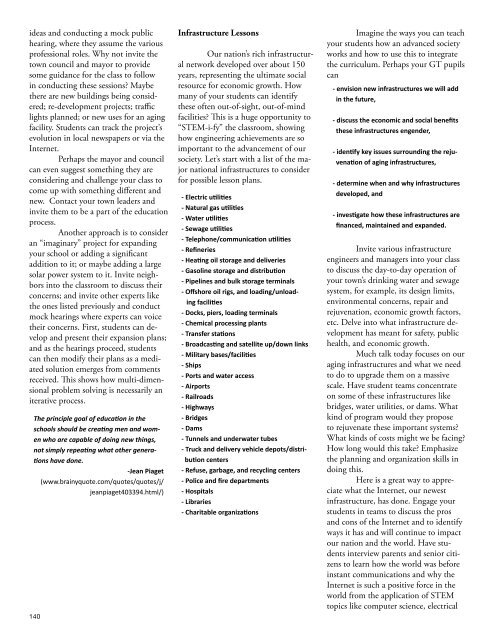Torrance Journal for Applied Creativity
TorranceJournal_V1
TorranceJournal_V1
Create successful ePaper yourself
Turn your PDF publications into a flip-book with our unique Google optimized e-Paper software.
ideas and conducting a mock public<br />
hearing, where they assume the various<br />
professional roles. Why not invite the<br />
town council and mayor to provide<br />
some guidance <strong>for</strong> the class to follow<br />
in conducting these sessions? Maybe<br />
there are new buildings being considered;<br />
re-development projects; traffic<br />
lights planned; or new uses <strong>for</strong> an aging<br />
facility. Students can track the project’s<br />
evolution in local newspapers or via the<br />
Internet.<br />
Perhaps the mayor and council<br />
can even suggest something they are<br />
considering and challenge your class to<br />
come up with something different and<br />
new. Contact your town leaders and<br />
invite them to be a part of the education<br />
process.<br />
Another approach is to consider<br />
an “imaginary” project <strong>for</strong> expanding<br />
your school or adding a significant<br />
addition to it; or maybe adding a large<br />
solar power system to it. Invite neighbors<br />
into the classroom to discuss their<br />
concerns; and invite other experts like<br />
the ones listed previously and conduct<br />
mock hearings where experts can voice<br />
their concerns. First, students can develop<br />
and present their expansion plans;<br />
and as the hearings proceed, students<br />
can then modify their plans as a mediated<br />
solution emerges from comments<br />
received. This shows how multi-dimensional<br />
problem solving is necessarily an<br />
iterative process.<br />
The principle goal of education in the<br />
schools should be creating men and women<br />
who are capable of doing new things,<br />
not simply repeating what other generations<br />
have done.<br />
-Jean Piaget<br />
(www.brainyquote.com/quotes/quotes/j/<br />
jeanpiaget403394.html/)<br />
140<br />
Infrastructure Lessons<br />
Our nation’s rich infrastructural<br />
network developed over about 150<br />
years, representing the ultimate social<br />
resource <strong>for</strong> economic growth. How<br />
many of your students can identify<br />
these often out-of-sight, out-of-mind<br />
facilities? This is a huge opportunity to<br />
“STEM-i-fy” the classroom, showing<br />
how engineering achievements are so<br />
important to the advancement of our<br />
society. Let’s start with a list of the major<br />
national infrastructures to consider<br />
<strong>for</strong> possible lesson plans.<br />
- Electric utilities<br />
- Natural gas utilities<br />
- Water utilities<br />
- Sewage utilities<br />
- Telephone/communication utilities<br />
- Refineries<br />
- Heating oil storage and deliveries<br />
- Gasoline storage and distribution<br />
- Pipelines and bulk storage terminals<br />
- Offshore oil rigs, and loading/unloading<br />
facilities<br />
- Docks, piers, loading terminals<br />
- Chemical processing plants<br />
- Transfer stations<br />
- Broadcasting and satellite up/down links<br />
- Military bases/facilities<br />
- Ships<br />
- Ports and water access<br />
- Airports<br />
- Railroads<br />
- Highways<br />
- Bridges<br />
- Dams<br />
- Tunnels and underwater tubes<br />
- Truck and delivery vehicle depots/distribution<br />
centers<br />
- Refuse, garbage, and recycling centers<br />
- Police and fire departments<br />
- Hospitals<br />
- Libraries<br />
- Charitable organizations<br />
Imagine the ways you can teach<br />
your students how an advanced society<br />
works and how to use this to integrate<br />
the curriculum. Perhaps your GT pupils<br />
can<br />
- envision new infrastructures we will add<br />
in the future,<br />
- discuss the economic and social benefits<br />
these infrastructures engender,<br />
- identify key issues surrounding the rejuvenation<br />
of aging infrastructures,<br />
- determine when and why infrastructures<br />
developed, and<br />
- investigate how these infrastructures are<br />
financed, maintained and expanded.<br />
Invite various infrastructure<br />
engineers and managers into your class<br />
to discuss the day-to-day operation of<br />
your town’s drinking water and sewage<br />
system, <strong>for</strong> example, its design limits,<br />
environmental concerns, repair and<br />
rejuvenation, economic growth factors,<br />
etc. Delve into what infrastructure development<br />
has meant <strong>for</strong> safety, public<br />
health, and economic growth.<br />
Much talk today focuses on our<br />
aging infrastructures and what we need<br />
to do to upgrade them on a massive<br />
scale. Have student teams concentrate<br />
on some of these infrastructures like<br />
bridges, water utilities, or dams. What<br />
kind of program would they propose<br />
to rejuvenate these important systems?<br />
What kinds of costs might we be facing?<br />
How long would this take? Emphasize<br />
the planning and organization skills in<br />
doing this.<br />
Here is a great way to appreciate<br />
what the Internet, our newest<br />
infrastructure, has done. Engage your<br />
students in teams to discuss the pros<br />
and cons of the Internet and to identify<br />
ways it has and will continue to impact<br />
our nation and the world. Have students<br />
interview parents and senior citizens<br />
to learn how the world was be<strong>for</strong>e<br />
instant communications and why the<br />
Internet is such a positive <strong>for</strong>ce in the<br />
world from the application of STEM<br />
topics like computer science, electrical


